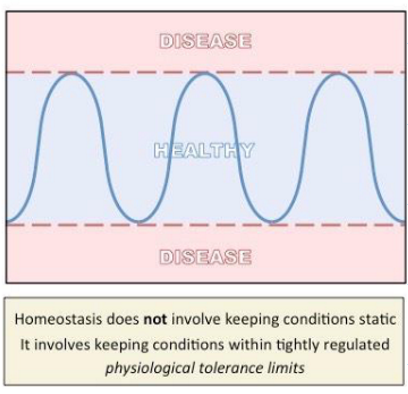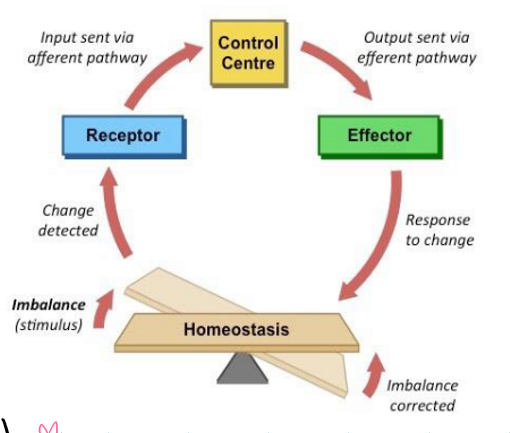What is physiology?
the study of the physical and chemical processes in cells, tissues, organs, and organ systems that work individually and together to sustain life
What is homeostasis?

the ability to maintain relatively stable conditions in the internal environment (despite changes in external environment)
What are some conditions considered in homeostasis?
1) pH
2) temperature
3) blood gases (CO2, O2)
4) blood pressure (b.p.)
5) intracellular + extracellular (ICF + ECF) fluid volumes
6) and many more!
why is homeostasis needed?
cells can only survive within a narrow range of conditions, therefore body conditions must be maintained within physiological limits
How does homeostasis work? What happens if it doesnt?
organ systems function together to maintain homeostasis
disease is a failure to maintain homeostasis
What are the roles of the nervous/endocrine system in homeostasis?
- control all other systems
- maintain homeostasis
- permit departures from homeostasis in a controlled manner e.g. pregnancy, growth, sudden fright
What is the general steps for the regulation of homeostasis?

What are the 2 types of nervous/endocrine responses?
anticipatory responses and feedback mechanisms
What are anticipatory responses?
- signal movement before a change in internal conditions (e.g. increased breathing at start of exercise, or putting on a coat before cold)
What are feedback mechanisms? What are the types?
- mechanisms that respond to change in system
- positive and negative (most common by a lot) feedback types
What are the 3 basic components of feedback mechanisms?
3 basic components: receptors, control areas, and effectors
What do the 3 basic components of feedback mechanisms do?
Receptors monitor variables/conditions
Control centers integrate info and maintain setpoints by signalling to effectors
Effectors create a response that will alter the variable/condition.
What are setpoints?
Setpoint = range of values of a variable (e.g. body temp.) that do not bring about a response (i.e. “normal range”)
What is the feedback mechanisms process?
- Variable/condition is monitored by receptors.
- Information from receptors (input) is fed back to the control area (Nervous System/endocrine gland).
- The control area (Nervous/Endocrine) then signals to the effector (output) which will bring about a response.
What are negative feedback mechanisms?
Most common homeostatic control mechanism
Result of “output” - variable moves back toward the set point i.e. in opposite (negative) direction to the change that triggered the response (“input”)
What are positive feedback mechanisms?
Less common - NOT homeostatic
Output of the feedback process intensifies the input – causes variable to move further away from set point (continues until an end point)
e.g. Childbirth – labour (end point is baby)
if negative feedback, what would body do if body temp increased to 40C
- dilated blood vessels bring warm core blood to the cooler skin surface and sweat evaporates.
- Results in increased heat loss & body temperature will decrease (opposite to the direction of the input/stimulus)